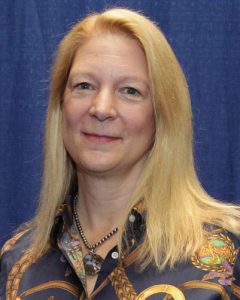SVG Sit-Down: Alteros President Jackie Green on the Aftermath of RF Reallocation
Wireless users still have a variety of issues to be resolved
Story Highlights
Alteros, the Audio-Technica wireless-microphone–technology spinoff launched in 2016, has just finished its first year of operations and sales, roughly contemporaneous with the first year under the FCC’s RF-spectrum reallocation. That made it a good time — just ahead of NAB 2018 in Las Vegas next week — to sit down with Alteros President/CTO Jackie Green to ask what she is seeing as the smoke around the RF reallocation clears and how Alteros’ first product, the 6.5-GHz GTX system, is faring in wireless’s brave new world.

Alteros’s Jackie Green: “We’ve been implementing [user feedback on the 6.5-GHz GTX], mostly around how we can better fit into their existing workflows.
There are a number of loose ends and a few new ends. Several White Space device makers and coalitions are still hoping for a single reserve channel in all markets. They’re still trying to talk the FCC into that. White Space devices have the Duplex Gap and Channel 37; wireless microphones can operate in the Duplex Gap, but they cannot operate in Channel 37. Mic manufacturers as well as Microsoft and other White Space-device–related coalitions have also requested that there be a vacant channel preserved in every market. There was an NPRM [Notice of Proposed Rulemaking] put out by the FCC in November that suggested that television stations can simulcast in their remaining spectrum as the transition to ATSC 3.0. There’s a little bit of open spectrum in 500 MHz that they can use, but that leaves even less for wireless microphones. It’s still unclear. Also, the RF databases aren’t fully working yet. And T-Mobile has been aggressively firing up their new devices to get a return on that $8 billion investment. They’ve been good at letting people know when they’re going to do that, but it’s still often unexpected. So, yeah, there are a number of loose ends out there.
Have wireless users become more aware that the 39-month transition period offered less breathing room than originally thought? Are customers moving in the right direction now? What can they do to improve their own situation?
They’ve realized that there is no guarantee that they would have up to three years of [uninterrupted] operations ahead of them. All of the active professional wireless users we talk to are actively getting out of the 600 MHz band now. But they also need to start purchasing alternative-spectrum gear. Of course, there’s only so much spectrum that’s left, so people will be bumping into each other, especially in the 500 MHz band. We’re not saying don’t use the 500 MHz band, but, especially when purchasing new gear, the message really is, you’ll have to use alternative spectrum and be ready to work in a lot of different bands now.
What has been Alteros’s experience in the 6.5 GHz range thus far? Any surprises on the technical or operational side?
We’ve had really good results there. We’ve already sold out of all of the first runs of manufacturing. [6.5 GHz] has been very stable, very solid. We’ve seen it deployed in several large cities, including New York and L.A. Seriously, I think the only surprises are on the customer side. People didn’t believe it would work so well or be as easy to work with as it actually is. The customers have been pleasantly surprised.
The GTX system was deployed by ESPN at the 2017 US Open tennis tournament, its first major broadcast-sports outing. What kind of input did you get from that, and how has it helped or changed anything?
We confirmed that the performance and stability and ease of use are all there and are performing as promised. We like to hear feedback from events like that, because it’s important to hear from experts who are actually using the gear in the field. As a result, we compiled a list of suggestions and comments, and we’ve been implementing many of them, mostly around how we can better fit into their existing workflows.
Some suggestions are part of a new product, the GTX-24 handheld microphone, which we’ll be showing at NAB. We had been going down one path with that product’s development, but input from users caused us to follow another path. The broadcast version of the microphone will have an interchangeable, detachable section that lets you put on a station flag and a talkback switch, if desired. Or you can use it without that. The microphone is modular, just like the GTX system itself is. When you think about it, a lot of pro-audio operation, including our new wireless, is really more like [that of] a computer now. Related to that, we’ve also changed the firmware design; we’re launching more in-depth network and control interfaces for the system. Again, it’s intended to fit better into users’ existing workflows. The new system is called L.A.W.N [Local Area Wireless mic Network], which better defines our operation and interfaces seamlessly with the new workflows.
What sports shows will GTX be used on this year?
Hopefully, all of them! Based on where we’ve gotten our sales from, I think everyone will hear them, from studio and outside events.
